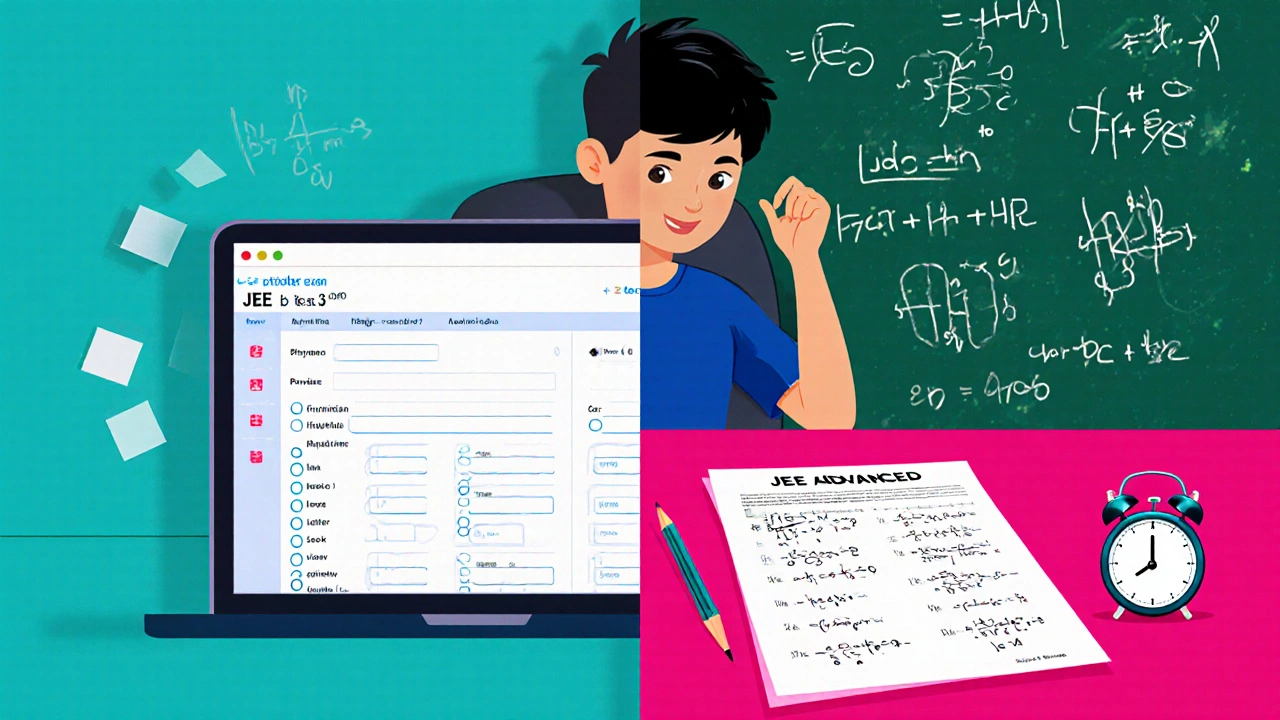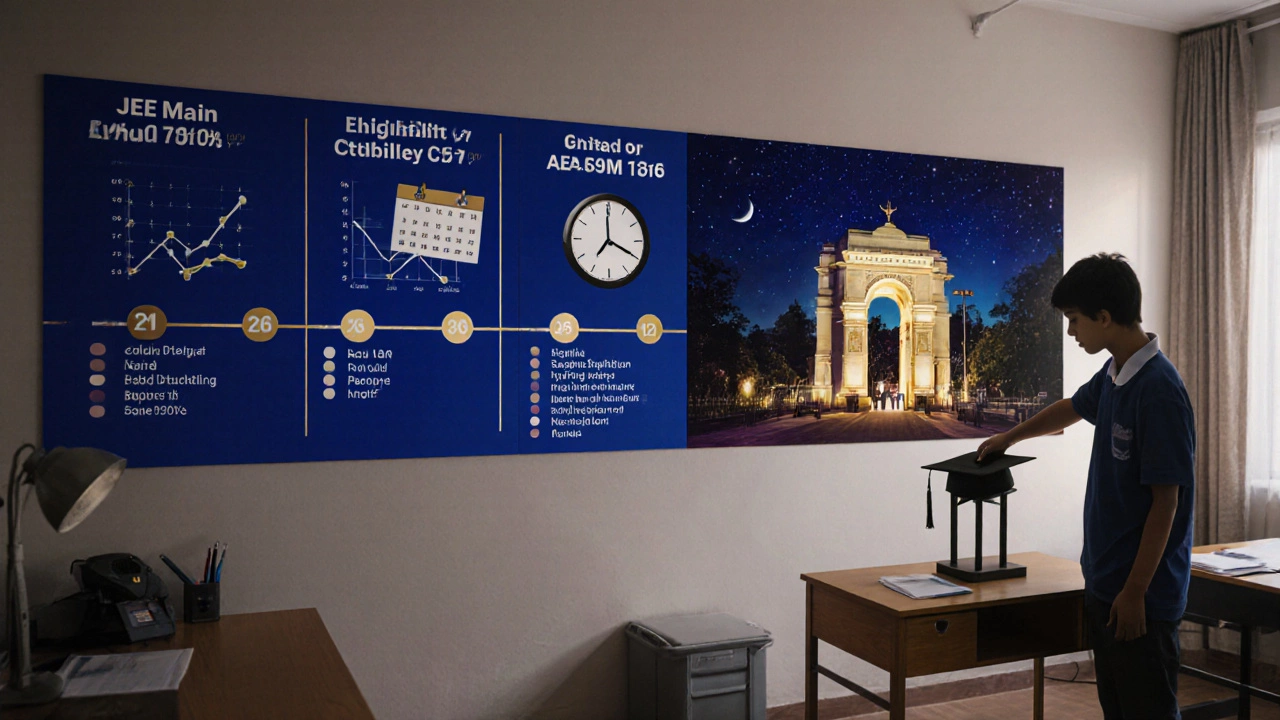JEE Main vs JEE Advanced Eligibility Calculator
JEE Main vs JEE Advanced Eligibility Calculator
When you start planning for the IIT entrance, the first question most students ask is: JEE Main vs JEE Advanced - which one should I focus on and how do they differ?
JEE Main is a national‑level engineering entrance exam conducted by the National Testing Agency (NTA) that serves as the gateway to undergraduate engineering programs across India and as the qualifying test for JEE Advanced. It is offered twice a year, in January and April, and is written in both offline (pen‑and‑paper) and online modes. For millions of students, clearing JEE Main is the first real milestone on the path to a top engineering college.
JEE Advanced is a high‑stakes entrance test organized by one of the Indian Institutes of Technology (IITs) on behalf of the Joint Admission Board (JAB). Only candidates who clear the JEE Main cutoff and meet other eligibility rules are allowed to sit for this exam, which is held once a year, usually in May. A good JEE Advanced rank can open the doors to any of the 23 IITs.
Eligibility Rules - Who Can Appear?
Understanding who can sit for each exam is the first practical difference. For JEE Main you need to be a student who has completed Class 10th or is appearing for Class 12th in the current or following year. The board of study can be CBSE, any state board, or even an international board, as long as the student has passed Class 10th.
For JEE Advanced the bar is higher. A candidate must:
- Secure a rank within the announced JEE Main cutoff (normally the top 2.5 lakh ‑ 3 lakh candidates nationwide).
- Have appeared in at least one of the two JEE Main sessions in the same admission year.
- Be born on or after 1 January 2005 (the age limit may shift slightly each year).
- Have taken only one of the three permissible attempts at JEE Main in a given year.
In short, JEE Main is open to a broad pool, while JEE Advanced is a filtered subset of the top performers. If you miss the JEE Main cutoff, the Advanced exam is out of reach.
Exam Pattern and Syllabus - What You’ll Face on Test Day
Both exams test Physics, Chemistry, and Mathematics, but the format and depth differ considerably.
| Aspect | JEE Main | JEE Advanced |
|---|---|---|
| Mode | Online (Computer Based Test) - both MCQ and Numerical Answer Type (NAT) | Hybrid - Paper‑1 (offline) and Paper‑2 (online) each with MCQ & NAT |
| Duration | 3 hours total (2 hours each for Paper‑1 and Paper‑2) | 3 hours per paper, two papers on the same day |
| Number of Questions | 90 questions (30 per subject) split between MCQ and NAT | Approximately 60 questions per paper, mix of MCQ, multiple‑select, and NAT |
| Marking Scheme | +4 for correct, ‑1 for wrong (only for MCQ); NAT no negative marking | Varies by question type; generally +4 for correct, ‑1 for wrong MCQ, no negative for NAT |
| Syllabus Depth | Class 11‑12 NCERT + some higher‑order problems | Advanced concepts, deeper problem solving, often beyond NCERT |
JEE Main focuses on testing fundamental understanding and speed, while JEE Advanced pushes you to apply concepts in novel ways, often requiring rigorous analytical skills. For example, a JEE Main physics question may ask for a straightforward application of Newton’s law, whereas an Advanced question could combine mechanics with thermodynamics in a multi‑step problem.
Scoring, Ranking, and Result Interpretation
Both exams generate separate scores for each subject and an aggregate total. However, the way rankings are computed differs.
- JEE Main: The All‑India Rank (AIR) is calculated based on the total marks out of 300. A normalized score accounts for varying difficulty across sessions. The result also publishes percentile scores for each subject, helping you see how you stack up against peers.
- JEE Advanced: Rankings are derived from the combined score of Paper‑1 and Paper‑2. Because the exam is tougher, the total marks are out of 360, and the rank list is shorter, usually limited to the top 2.5 lakh‑3 lakh candidates. Additionally, a separate rank is released for each chosen branch (e.g., Computer Science, Electrical), which directly influences the seat you get.
For most students, the JEE Main score decides whether they move on to JEE Advanced, while the JEE Advanced rank determines which IIT and which branch they can secure.

Number of Attempts and Timing - How Often Can You Try?
JEE Main can be attempted twice in a single admission year (January and April) and you may re‑appear in subsequent years without a limit, provided you meet the age and education criteria. This flexibility lets you improve your percentile over time.
JEE Advanced, on the other hand, permits only one attempt per year and a maximum of two attempts in total across all years. This restriction makes each shot crucial, and most aspirants plan their preparation to peak for the first eligible JEE Advanced attempt.
Admission Process - Where Does Each Exam Lead?
Understanding the end goal of each exam clarifies why the differences matter.
- JEE Main Pathway:
- Clearing JEE Main opens doors to NITs, IIITs, and other government‑aided engineering colleges that admit based on the Joint Seat Allocation Authority (JoSAA) counseling.
- Students with a good JEE Main rank but not enough for JEE Advanced can still secure seats in prestigious NITs like NIT Trichy or NIT Warangal.
- JoSAA also allocates seats in GFTIs (Government Funded Technical Institutes) based purely on JEE Main ranks.
- JEE Advanced Pathway:
- Only JEE Advanced rank decides admission to the 23 IITs. Each IIT has its own cutoff for different branches, and the final allocation is handled by JoSAA after JEE Advanced results.
- Higher JEE Advanced rank gives you a better chance at coveted branches such as Computer Science at IIT Bombay or IIT Delhi.
- Some IITs also run super‑numerary seats for NRI/foreign candidates, again based on JEE Advanced rank.
In essence, JEE Main is the broad gateway; JEE Advanced is the exclusive hallway that leads straight to the IITs.

Preparation Strategies - Tailoring Your Study Plan
Because the exams test different depths, a one‑size‑fits‑all study plan won’t work.
- Start with JEE Main fundamentals: Master NCERT textbooks, solve previous year papers, and practice timed mock tests. Focus on speed and accuracy, because the cutoff is often determined by a few marks.
- Layer in Advanced concepts after you’ve cleared the JEE Main cutoff: Dive into higher‑level problems from books like “IIT Mathematics” by Arihant, work on Olympiad‑style questions, and join a test series that mimics JEE Advanced’s pattern.
- Mind the timeline: Allocate the first 8‑10 months to JEE Main preparation, then shift 2‑3 months to intensive JEE Advanced revision if you qualify.
- Track performance metrics: Use tools to monitor your percentile in JEE Main mocks and your rank projection for JEE Advanced. Adjust study intensity based on gaps.
- Stay healthy: Regular breaks, light exercise, and proper sleep keep your brain sharp for the long hours of problem solving required by both exams.
Key Takeaways
- JEE Main is open to all eligible Class‑12 students, conducted twice a year, and serves as the qualifier for JEE Advanced.
- JEE Advanced is only for the top JEE Main rankers, held once a year, and directly determines IIT admission.
- Exam patterns differ: JEE Main leans on speed, JEE Advanced on depth and problem‑solving.
- Scoring systems and rank calculations are distinct; JEE Advanced ranks are narrower but carry higher weight for IIT seats.
- Strategic preparation means mastering JEE Main first, then transitioning to JEE Advanced once eligibility is secured.
| Feature | JEE Main | JEE Advanced |
|---|---|---|
| Conducting Body | National Testing Agency (NTA) | Joint Admission Board (JAB) on behalf of IITs |
| Eligibility | Class 10 pass or appearing in Class 12 | Top JEE Main rankers + age & attempt limits |
| Frequency | Two sessions per year | One session per year |
| Mode | Online (CBT) - MCQ & NAT | Hybrid - Paper‑1 offline, Paper‑2 online |
| Total Marks | 300 | 360 |
| Purpose | Admission to NITs, IIITs, GFTIs; qualifier for Advanced | Admission to IITs only |
| Maximum Attempts | Unlimited (subject to age) | Two total attempts |
Frequently Asked Questions
What is JEE Main?
JEE Main is a national engineering entrance exam conducted by the NTA. It evaluates candidates in Physics, Chemistry, and Mathematics and is the first step toward admission to NITs, IIITs, and as a qualifier for JEE Advanced.
What is JEE Advanced?
JEE Advanced is the second‑stage exam organized by the Joint Admission Board. Only students who meet the JEE Main cutoff can appear, and the exam decides admission to the 23 IITs across India.
Can I appear for JEE Main and JEE Advanced in the same year?
Yes. You must first sit for JEE Main (January or April). If you secure a rank within the announced cutoff, you become eligible to write JEE Advanced, which is usually scheduled in May of the same year.
How is JEE Advanced eligibility determined?
Eligibility hinges on three factors: (1) achieving a rank within the JEE Main cutoff, (2) being born after the stipulated date (typically 1 January 2005), and (3) not exceeding the maximum number of attempts allowed.
What is the typical cutoff for JEE Main?
Cutoffs vary each year based on difficulty and total candidates. In recent years, the All‑India rank cutoff for JEE Advanced eligibility has hovered around 2.5 lakh to 3 lakh, which translates to an approximate percentile of 85‑90% in JEE Main.
